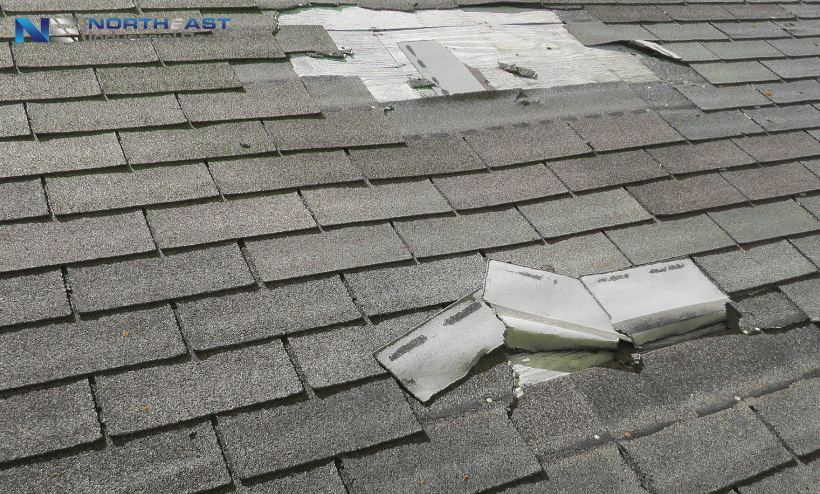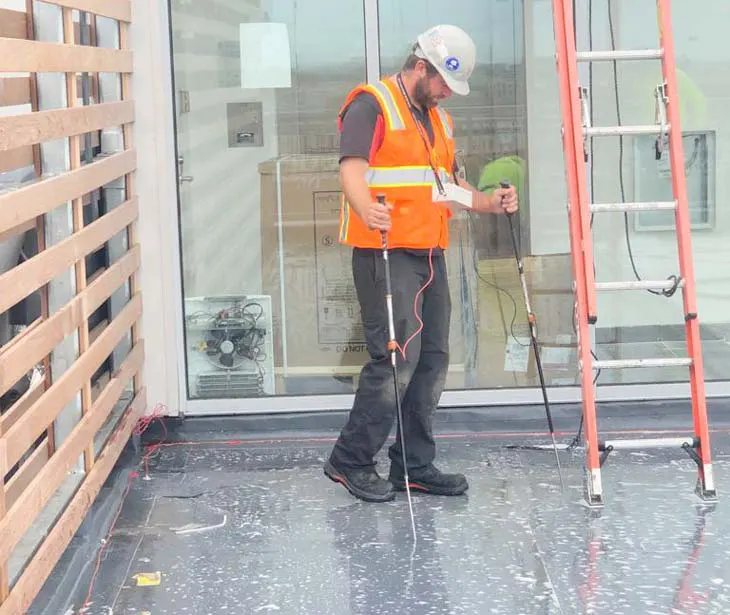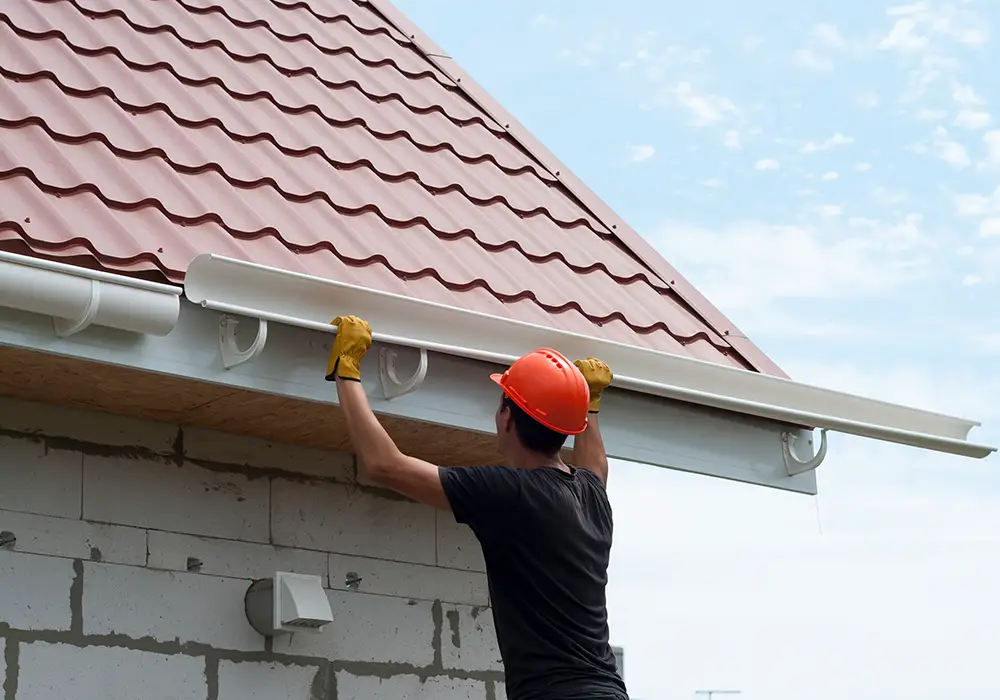Is a Solar Energy System Right for Your Commercial Roof?
October 1st, 2020
As solar roofing systems become more affordable and less cumbersome, commercial building owners are discovering the efficacy of adopting solar energy to lower overhead costs.
What is a Solar Roof?
A solar roofing system (aka PV or photovoltaic system) is used to convert photons (energy particles found in sunlight) into electricity that can be used to supply power to the building on which it is installed. Solar energy conversion was discovered and put to use in the late 1800s and continues to evolve and advance today.
Solar panels contain individual solar cells composed of layers of silicon, phosphorus and boron, elements that work together to create a balance of positive and negative charges, absorb photons and produce usable energy. This process is referred to as a photovoltaic effect. In a well-constructed solar energy system, more electricity is produced than is used in a day, allowing stores of power to build up and be used for nighttime electricity or sold into the local power grid (net metering).
Types of Solar Options
Solar panels are installed on an existing roof, which is considered a positive aspect by building owners who are not looking to replace the entire roof. The technology is cost effective, established and reliable; however, the visual appeal of solar panels leave a lot to be desired, in some people’s opinions, as they’re only available in black or blue and are installed using a bracket system on top of the roof.
Solar panels, as a well-established technology, are easy to install by installers who have been installing them for years and they do not need to cover the whole roof to be effective. Furthermore, the bracketing system, while deemed unattractive by some, allows the individual panels to be adjusted to catch the most direct sunlight.
Solar Panel Attachment Methods
Ballasted Racking: This method uses concrete blocks to anchor the PV system to the flat roof. Another version of the ballasted racking system is the hybrid ballasted system, which uses mechanical fasteners in addition to the heavy blocks to attach the system to the roof. Like all types of ballasted roofing, it’s heavy and requires the building to have a highly integral structure to support the weight of the ballast and the PV system.
Attached Racking: This method uses roof-penetrating fasteners to attach the PV system to the roof. This method can be used on low-slope or flat roofs, though local building codes will determine whether an individual roof is suitable for this attachment method.
Solar Shingles & Tiles
Solar shingles or tiles are integrated into traditional roofing systems. This system is referred to as a building integrated photovoltaic (BIPV) system. Solar tiles, or BIPV systems, are a newer, more updated technology than traditional solar panels. While newer technologies often come with uncertainties regarding reliability and other factors, solar tiles have amassed significant industry support in recent years.
Solar tiles are popular in part due to the fact that they are designed to look like traditional roofing shingles, with a range of options for textures and colors; however, they are not suitable for every type of roof design and are typically used for residential application.
What Roofing Materials Best Support Commercial Solar Roofing Systems?
When considering your options for solar energy systems, keep in mind that each type of roofing material has its own set of benefits and drawbacks.
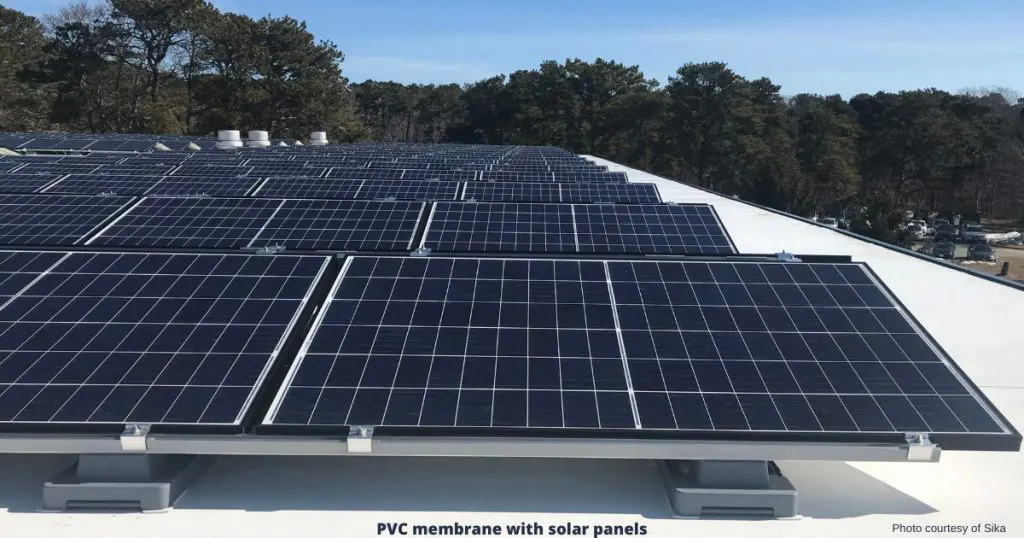
PVC Roofing
- Durable and weather-resistant: Resists water, wind, hail, lightning, and impact damage.
- Energy efficient: Insulation and reflectiveness make this material a smart option for reducing energy consumption and pairs well with PV systems.
- Fire retardant: Material is flame tested and self-extinguishes in seconds.
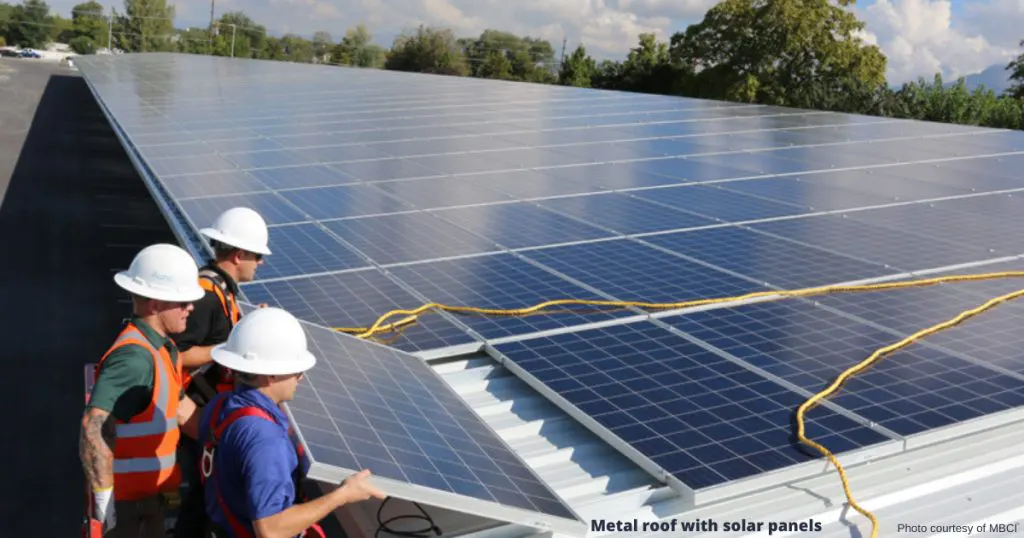
Metal Roofing
- Inherent reflectivity provides energy efficiency and keeps the building cooler than traditional roofing materials; adding a PV system provides shade to the roof to keep it even cooler.
- Cost savings: A metal-roof-and-solar-panel combo creates substantial opportunity for reduced energy consumption and lower electric bills by helping to regulate the building’s interior temperature.
- Longevity: Metal roofing can last 30-60 years, meaning your roof won’t need to be replaced before your solar panels.
- Easy install: With standing seam metal roofs, solar panel racks can be clamped onto the seams, eliminating the need to penetrate the roof during attachment.
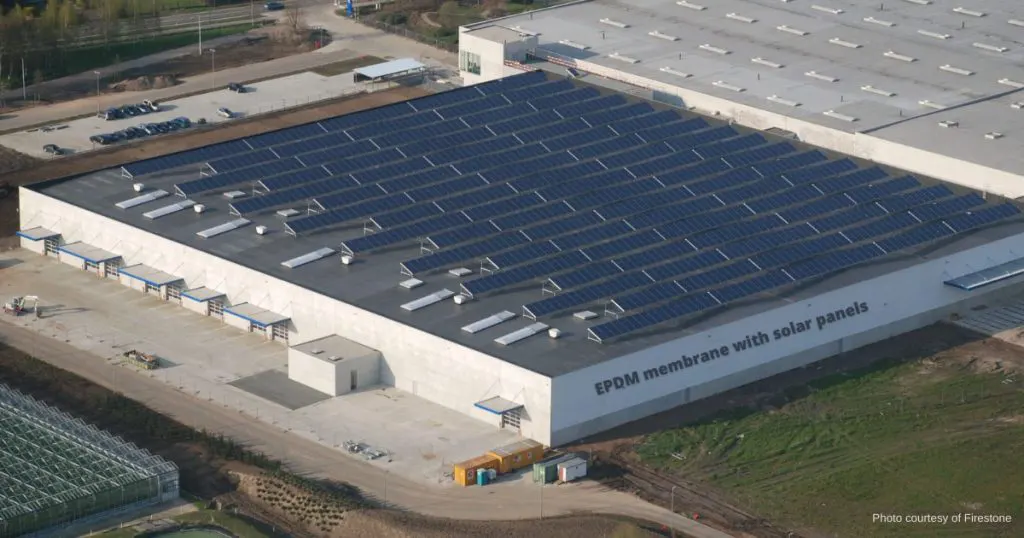
EPDM Roofing
- Reflectivity comes with a special white coating created to help reflect UV rays; can potentially increase solar production.
- Weather resistant: EPDM (rubber) roofing provides resistance to water, degradation, mold, thermal shock and impact damage.
- No penetration necessary: When installing solar panel systems on an EPDM membrane, a weighted mounting system will typically be used in order to protect the integrity of the roof. This method is also faster and more cost effective.
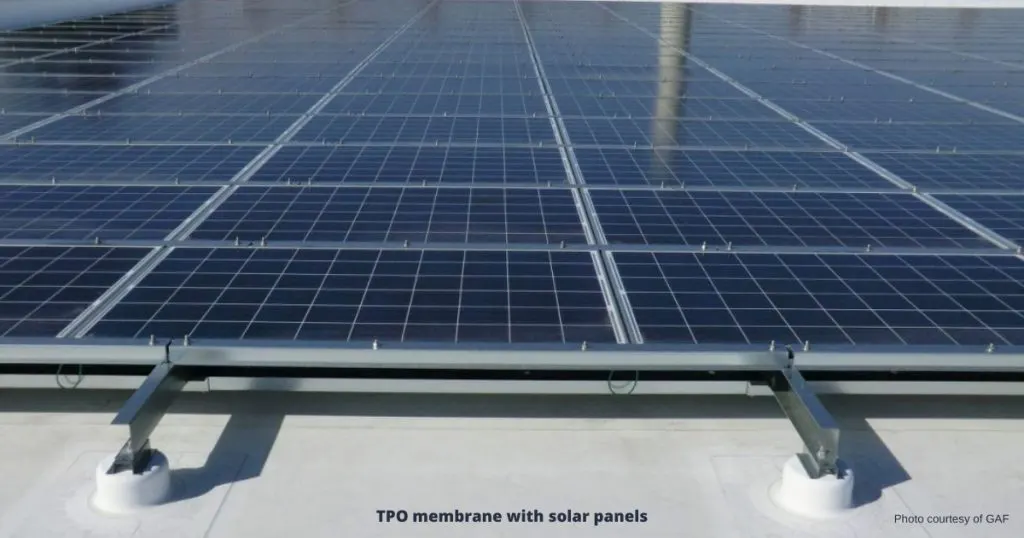
TPO Roofing
- Relatively low initial cost compared to other roofing materials.
- Durability: TPO is flexible enough to adapt to the building’s natural movement, making it unlikely to crack.
- Flat roofs tend to be more ideal when installing solar panels. Using the weighted mounting system is faster, more cost effective and doesn’t require holes, ensuring the roof’s structural integrity stays intact.
Benefits of Solar Roofing
Solar roofing is a good choice regardless of your building’s size. Whether your building’s roof is vast or a bit on the smaller side, a solar roofing system can provide the same benefits to your business.
Financial benefits
Solar roofing can provide an excellent return on investment and should be considered an investment rather than an expense. Some of the most notable financial benefits of investing in a PV system include the following:
- They’re affordable. The costs associated with installing PV systems have dramatically decreased since the early 2010s – depending on the area, the initial cost is up to 70% lower than a decade ago. Combined with the savings on recurring energy costs, possible cash rebates and tax incentives, PV systems have never been more affordable than they are in 2020. Ask us about available financing options.
- Energy cost savings. Companies of all sizes have reported saving up to 89% in monthly energy costs after installing solar roofing systems. As these roofing systems can generate most of the electricity needed for normal building operations, business owners find that these systems often more than pay for themselves over the life of the roof.
- Increased property value. PV systems add substantial value to commercial buildings, and buildings with these systems tend to sell faster and for more money than buildings that lack them.
- Tax incentives. As of 2020, owners of new commercial and residential PV systems benefit from the Solar Investment Tax Credit (ITC), which provides a 26% federal tax credit if the solar panels are installed by the end of the year. A 100% bonus depreciation allows businesses to take an immediate first-year deduction on new PV installations.
- Added income streams. For commercial buildings that produce more energy than they need for regular operations, there is often the opportunity to sell the extra electricity back to the power company – revenue which can help to offset the initial cost of new system installation.
- Competitive advantages. Businesses that opt for solar energy are often viewed positively by potential customers and community members. Additionally, the cost savings provided by the system may allow the company to price its goods and services more competitively than other companies in the same industry as well as redirect cost savings to increase marketing, customer service or quality control budgets.
Aesthetics
While early versions of solar roofing systems could be an aesthetic burden due to their bulky appearance, today’s solar options include photovoltaic shingles, which mimic the look of regular roofing shingles, with a wide variety of textures, colors and attachment methods available to fit the desired aesthetic of the building.
Durability
Commercial PV systems require very little maintenance, do not contribute to noise pollution and are weather-resistant. The solar cells are built to last, with protective tempered glass and corrosion-resistant aluminum framing and are strong enough to withstand wind, rain, snow and hail. Furthermore, PV systems tend to be more reliable than traditional electricity and will continue to provide electricity during a power outage*.
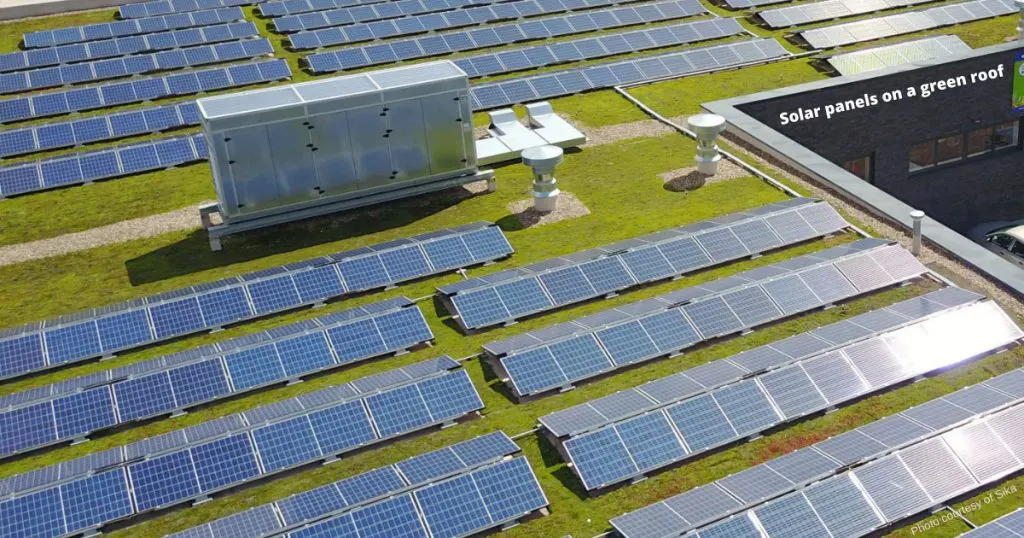
Eco-friendly
In the U.S., buildings produce nearly 40% of the country’s CO2 emissions – more even than vehicles, which clocks in at about 33%. By adopting a solar-powered roofing system, businesses owners can greatly reduce their company’s carbon footprint, contribute to a reduction in the urban heat island effect and an increase of the quality of the environment for the entire community.
*Solar panels will continue to provide power to the building while the sun is shining and battery backups are functioning properly. Lack of a battery backup system will cause your solar-powered building to lose power during a power outage since the power generated by these systems is sent through the local power grid rather than supplying your building directly.
Is a Solar Roofing system Right for Your Commercial Building?
Converting to solar power can be a daunting decision for business owners, and there are several factors to consider when making a choice, including:
- Age, condition and structural integrity Today’s PV systems are lightweight, but the structural integrity of the roof should still be considered for safety and effectiveness. An older roof may be nearing the end of its useful life, so it may be prudent to replace it before having solar panels installed.
- Access to sunlight For maximum effectiveness, solar panels should be installed in a spot in which they are exposed to direct sunlight for the majority of the day. The panels will work in the shade, but much less effectively.
- Size, shape and layout of the roof Even awkward shapes or layouts shouldn’t be difficult to work with using today’s advanced solar technology. There are several options for roofs of all sizes and shapes, so your building’s unusual layout is no longer automatically considered a hindrance to installing solar power systems.
- Tax incentives Building owners who have a PV system installed by the end of 2020 will be able to reap the largest tax incentives; beginning in 2021, available tax credits are scheduled to steadily decrease, so for tax purposes, installing solar panels sooner rather than later is more advantageous.
- Return on investment In addition to the tax benefits afforded to new solar owners, a PV system is said to pay for itself over its lifetime in energy savings, increased property value and low maintenance costs.
- Maintenance requirements Solar roofing systems require very little maintenance to perform optimally. However, it is important to have regular inspections to ensure that the system is in good condition and performing as it should.
- Installation More often than not, if a property owner experiences problems with their solar power system, it can be attributed to faulty installation. To avoid such problems, make sure that you hire an experienced roofing contractor who is experienced in PV or BIPV system installation and who specializes in commercial roofing.
Northeast Industrial Roof’s roofing experts are extensively trained, experienced and knowledgeable of the various options and considerations for commercial roofing systems, including solar power options. Our certified technicians can perform a thorough inspection as well as help you navigate the process of having solar panels installed on your commercial roof.

